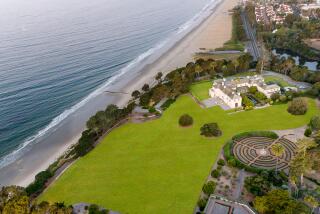Clearing the Air on the Balboa Peninsula’s King Gillette Mansion
- Share via
Newport Beach has a mythology all its own. The town’s capacity for myth-making is nearly as predictable as the tides that bathe it. And nearly as changeable.
A fine example was encapsuled in a Times article (April 10) about an architectural monument at the tip of the Balboa peninsula known as the “King Gillette Mansion.”
Properly speaking, it was King G. (not C.) Gillette, the son, not the inventor of the safety razor, who bought the site and built the home in 1925 (not ‘26), after Newport contractor Paul B. Ellsworth took out a building permit for a nine-room (not 23), shingled structure to cost $12,000 (not $24,000).
Among Balboa’s best-nurtured tales is that Gillette never spent a night in the place. In a feature story last year, Beatrix Padway, whose father-in-law once owned the place, opined, “Gillette never moved in because his wife fell in love with the architect and they ran off.” This year’s Times version has it that just as Gillette and a convoy of moving vans approached, a wave of biblical proportions swept over the roof, whereupon Gillette turned tail, ne’er to return.
If so, he missed the better part of eight years’ construction, which included two more stories, a whole second half and 14 additional rooms. Following these post-wave improvements, Gillette sold the property in 1933 to R.V. Jones (not the Padway brothers), of Hollywood, for $75,000.
Next comes the cherished “feuding (Padway) brothers and house divided” story. It likewise falls.
In November of 1936 (not ‘31), Jones (not Gillette) sold the residence to Barney Padway, president of a Beverly Hills mortgage company. It was Barney (not Martin and James) Padway who immediately remodeled the three-story spread into two Mediterranean houses. Far from any “brotherly feud,” Padway occupied one half, while the other half was designed for his brother, Judge Joseph A Padway, of Milwaukee, Wis. When completed, each half contained 15 rooms.
Ultimately the Padways would occupy the landmark until World War II, when it was taken over by the military. Alas, it was the Army (not the Coast Guard) who commandeered the mansion for a base from which two 104-foot crash boats were dispatched to retrieve downed fliers at sea.
Two years after the war, Barney Padway sold the “divided house” to Andrew and Lucille Bailey for $40,000. After sprucing it up, the Baileys sold in 1972 to Dr. Jim Diffley for $150,000.
Reflecting a continuing rise in real estate values, the showplace sold again in 1976, this time for $275,000. As is well known, the purchaser was aging guitar-twanger Richard Anthony Monsour (also known as Dick Dale), “King of the surfing fender-benders.” At this point, the beach house was described as 17 rooms with six baths.
In 1986, Dale was evicted after defaulting on his mortgage (though sex makes better reading). Then in considerable disrepair, the place passed to the Federal Deposit Insurance Corp. from which Al and Loyce Grasso bought it.
However, The Times was perfectly correct in stating that the Grassos are now in the process of restoring the $1.4-million fixer-upper to its mid-1930s Mediterranean grandeur.
I trust that these facts will not confuse the harbor cruise directors, whose “ferry” tales have been such a fecund source of local history--especially those regarding the “King Gillette House.”
JIM SLEEPER
Tustin
Jim Sleeper is an author-historian who specializes in Orange County history.


